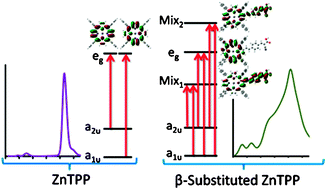A spectroscopic and DFT study of thiophene-substituted metalloporphyrins as dye-sensitized solar cell dyes†
Abstract
A combination of density functional theory calculations, electronic absorption and

* Corresponding authors
a
MacDiarmid Institute for Advanced Materials and Nanotechnology, Department of Chemistry, University of Otago, Dunedin, New Zealand
E-mail:
kgordon@chemistry.otago.ac.nz
Fax: +64 3 473 7906
b Intelligent Polymer Research Institute and ARC Centre for Electromaterials Science, University of Wollongong, Northfields Avenue, Wollongong, Australia
A combination of density functional theory calculations, electronic absorption and

 Please wait while we load your content...
Something went wrong. Try again?
Please wait while we load your content...
Something went wrong. Try again?
S. J. Lind, K. C. Gordon, S. Gambhir and D. L. Officer, Phys. Chem. Chem. Phys., 2009, 11, 5598 DOI: 10.1039/B900988D
To request permission to reproduce material from this article, please go to the Copyright Clearance Center request page.
If you are an author contributing to an RSC publication, you do not need to request permission provided correct acknowledgement is given.
If you are the author of this article, you do not need to request permission to reproduce figures and diagrams provided correct acknowledgement is given. If you want to reproduce the whole article in a third-party publication (excluding your thesis/dissertation for which permission is not required) please go to the Copyright Clearance Center request page.
Read more about how to correctly acknowledge RSC content.
 Fetching data from CrossRef.
Fetching data from CrossRef.
This may take some time to load.
Loading related content
